ATI's Radeon X800 XL 512MB - A toe in the 512MB pool
by Anand Lal Shimpi on May 4, 2005 9:27 AM EST- Posted in
- GPUs
At the end of last year, ATI announced 5 new GPUs, three of which were supposed to be available within a week of the announcement, none of which actually were. One of those GPUs, the X800 XL, was of particular interest as it was ATI's first real answer to NVIDIA's GeForce 6800GT and ATI said that it would be priced a full $100 less than NVIDIA's offering. Of course, that GPU didn't arrive on time either. And when it did, you had to pay a lot more than $299 to get it.
Fast forward to the present day and pretty much everything is fine. You can buy any of the GPUs that ATI announced at the end of last year at or below their suggested retail prices. But, we have another GPU release on our hands, and given ATI's recent track record, we have no idea if we're talking about a GPU that will be out later this month as promised or one that won't see the light of day for much longer.
Today, ATI is announcing their first 512MB graphics card - the Radeon X800 XL 512MB. Priced at $449, ATI's Radeon X800 XL 512MB is identical in every aspect to the X800 XL, with the obvious exception of its on-board memory size. The X800 XL 512MB is outfitted with twice as many memory devices as the 256MB version, but ATI is indicating that there's no drop in performance despite the increase in memory devices. The clock speeds of the X800 XL 512MB remain identical to the 256MB version, at 400MHz core and 980MHz memory. The 512MB version is also built on the same 0.11-micron R430 GPU as the 256MB version; in other words, the GPUs are identical - one is just connected to twice as much memory. Right now, the X800 XL 512MB is PCI Express only.
The board layout and design hasn't changed with the move to 512MB. The power delivery circuitry is all the same. The difference is that now there are twice as many memory devices on the PCB.
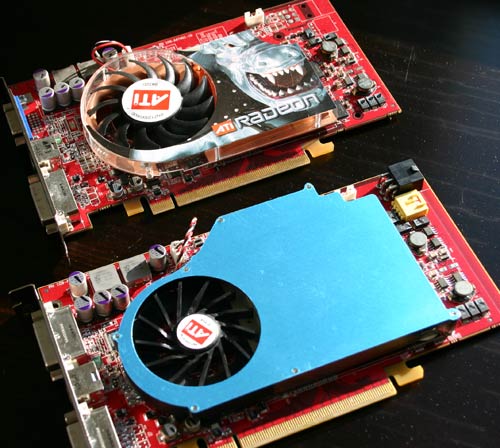
The two X800 XLs: 512MB (lower), 256MB (upper).

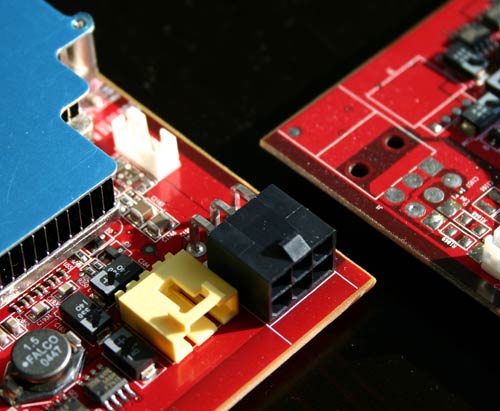
The X800 XL 512MB also now requires the 6-pin PCI Express power connector, something that the original 256MB board didn't need.
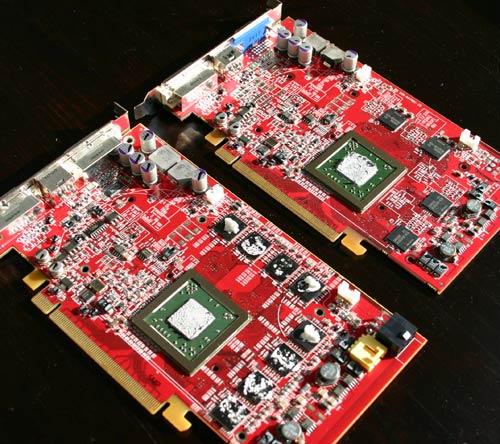
The X800 XL 512MB achieves its memory capacity by using twice the number of chips as the 256MB version.
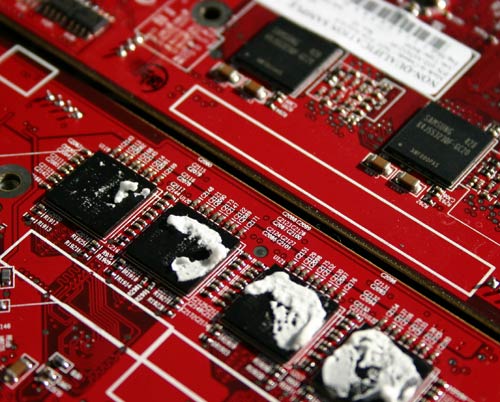
This is where ATI's strategy doesn't seem to make much sense. They are taking a mid-range performance part, the X800 XL, and giving it more memory than any of their GPUs, thus pricing it on par with their highest end X850 XT. More than anything, ATI is confusing their own users with this product. Those who are uninformed and have a nice stack of cash to blow on a new GPU are now faced with a dilemma: $449 for a 512MB X800 XL or $499 for a 256MB X850 XT? That is, if this part does actually ship to market in time and if it is actually priced at $449 - both assumptions that we honestly can't make anymore given what we've seen with the past several ATI releases.
What's also particularly interesting about today's 512MB launch is that ATI won't be producing any 512MB X800 XL cards under the "built by ATI" name. You will only be able to get these cards through ATI's partners. According to ATI, the following manufacturers will bring the X800 XL 512MB to market sometime this month:
- GigabyteAnd as confirmation, here's a slide from ATI's presentation saying the exact same thing:
- TUL
- Sapphire
- HIS
- MSI
- ABIT
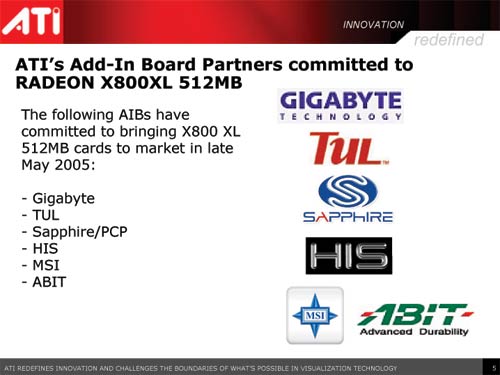
It is worth noting that NVIDIA has been shipping a 512MB card, the 512MB GeForce 6800 Ultra, for quite some time now. However, the card itself only seems to be available to system builders such as Alienware and Falcon Northwest. The 512MB 6800 Ultra is extremely expensive and appears to add around $800 to the cost of any system built by those who carry it; obviously, not in the same price range as ATI's X800 XL 512MB. Despite our curiosities, we could not get a card from NVIDIA in time for this review, although we'd be willing to bet that our findings here with the X800 XL 512MB would apply equally to NVIDIA's 512MB GeForce 6800 Ultra as well.










70 Comments
View All Comments
civilgeek - Thursday, May 5, 2005 - link
aliasfox - Thursday, May 5, 2005 - link
Actually, g33k, because nVidia's gotten lazy on the driver side of things, the X800XT is just as fast as the 6800 Ultra DDL in most instances, if not a little faster.I'd love to see nVidia put as much effort into its Mac OpenGL drivers as it does in its Windows OpenGL drivers... or, conversely, ATi should work as hard on its Windows OpenGL drivers as it does on the Mac.
nserra - Thursday, May 5, 2005 - link
512MB card is pointless I agree, but about the DOOM3 ULTRA mode require 512Mb of GPU memory, well maybe it’s correct. Only if you have an nvidia card!Ati cards use much less GPU memory for the textures and for AA and AF modes.
See "past" bench’s of nvidia 5x00 256MB vs ATI 9x00 256MB, while there was some performance decrease on the nvidia cards on games (max details settings) when going from 256MB to 128MB with the Ati there was no difference.
(Or performance increase if you do the opposite calculations [128 to 256])
ET - Thursday, May 5, 2005 - link
BTW, I agree that most evidence seems to point to ExtremeTech having made some mistake, but I love to verify things.ET - Thursday, May 5, 2005 - link
Yes, Anand, if you could do a 2GB test in both High and Ultra modes, I'd love to see it. Thanks!geekfool - Thursday, May 5, 2005 - link
Of course if this article benchmarked something that actually needed this memory, say Celestia (http://shatters.net/celestia/) /w a 64k texture set of Earth, the 512m of ram might have made a difference.flatblastard - Thursday, May 5, 2005 - link
And I'll get more use out of mine over a longer period of time. Ahhhh, I feel better now...g33k - Thursday, May 5, 2005 - link
"1) ATI is better at OpenGL than Nvidia"I know its been posted before, but you have this statement completely @ss backwards. Nvidia EXCELS at OPENGL. ATI tends to do better at DirectX games.
So if you follow your logic about the Apple platform(which admittedly I know nothing about), the 6800 Ultra would be the best card for the Mac.
flatblastard - Thursday, May 5, 2005 - link
Now at least when someone tries to make me feel bad for "wasting" my money on an x850xt pe, I will have someone else to point the finger at.Yes, I'm talking to you, whoever read this review and still plans on buying one of these 512MB cards! lol...
You know, I just realized.....with this new x800xl 512mb in the line-up, my x850xt pe starts to look like it was a good decision on my part.....I don't feel so cheated anymore. ;)
Ged - Wednesday, May 4, 2005 - link
"However, I disagree with your second post. If it were that simple, why do rendered games need so much RAM? I am pretty sure there are other things stored in video RAM when rendering the OS in 3D including textures. I think the days of the VRAM being used as JUST a frame buffer in the OS are numbered."It's true that you won't just need to store 'what the screen looks like' in VRAM; however, I cannot see how a clean desktop, which OSX is supposed to have, takes up 256MB or 512MB of VRAM.
Another way to look at the 20 frames at 2560x1600x24bbp is that you could store that many textures at that resolution as well. That should be overkill for a desktop (consider that all the windows are textured they'd probably use the same texture and other objects on the desktop would probably also use the same textures).
Take the best most complex 3D game with many textures on possibly hundreds of objects right now: They don't require over 256MB of VRAM and Apple's sleek, efficient Desktop will?
Plus, with NVIDIA and ATI both using System Memory via PCIe, you don't need as much VRAM for a 2D/3D desktop because the cards could use System RAM (assuming Apple goes to PCIe at some point).
"Graphics Cards for Apple OSX needing 256MB+ or 512MB of VRAM to display the OS well."
I guess I will sum it all up by saying: "I'll believe it when I see it" :)